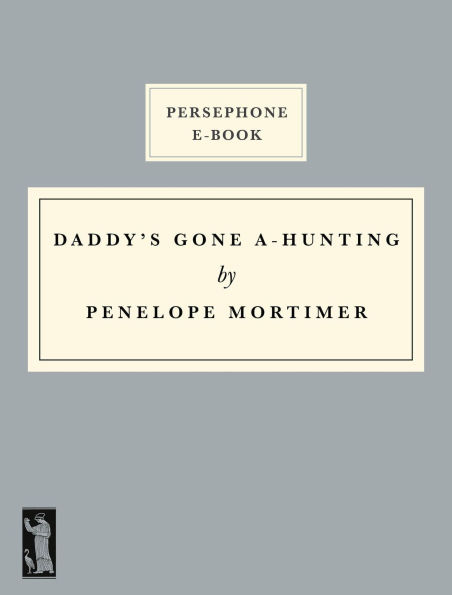Daddy's Gone A-Hunting, a 1958 novel by Penelope Mortimer, is about the expectations of women, about a house-bound mother reluctantly (desperately) at home all day, in contrast to her daughter who has escaped, to university and then, we can assume, to a job.
'The book came out at a time,' writes Valerie Grove in the Preface, 'when the impact of the new wave of feminism, which would change everything under the banner of women's liberation, had not yet arrived'. To put Daddy's Gone A-Hunting in context, it was first published five years before Betty Friedan's The Feminine Mystique and eight years before Hannah Gavron's The Captive Wife, and yet shares a number of similar themes. For example:
The relationships between the men are based on an understanding of success. Admiration is general, affection not uncommon. Even pity is known. The women have no such understanding. Like little icebergs, each keeps a bright and shining face above water; below the surface, submerged in fathoms of leisure, each keeps her own isolated personality. Some are happy, some are poisoned with boredom; some drink too much and some, below the demarcation line, are slightly crazy; some love their husbands and some are dying from lack of love; a few have talent, as useless to them as a paralysed limb. Their friendships, appearing frank and sunny, are febrile and short-lived, turning quickly to malice. Combined, their energy could start a revolution.
In Ruth Whiting's commuter-belt village 'the wives conform to a certain standard of dress, they run their houses along the same lines, bring their children up in the same way; all prefer coffee to tea, all drive cars, play bridge, own at least one valuable piece of jewellery and are moderately good-looking.' Yet Ruth is on the verge of going mad. A 'nervous breakdown' would be a politer phrase, but really she is being driven mad by her life and her madness is exacerbated by everyone's indifference to her plight:
Although Daddy's Gone A-Hunting is at times excruciatingly funny in its caustic dissection of the people among whom the Whitings live, it is also a profound study of female isolation. As the critic Judy Cooke has pointed out, Penelope Mortimer's novels were 'intense, imaginative explorations of an inner world. It is an enclosed world, dominated by fear, in which physical experiences such as sterilisation and abortion isolate her characters from their fellow beings and are metaphors for a deeper spiritual isolation.'
Endpaper
'Saraband' 1956, designed by R McGowan for Edinburgh Weavers
Daddy's Gone A-Hunting, a 1958 novel by Penelope Mortimer, is about the expectations of women, about a house-bound mother reluctantly (desperately) at home all day, in contrast to her daughter who has escaped, to university and then, we can assume, to a job.
'The book came out at a time,' writes Valerie Grove in the Preface, 'when the impact of the new wave of feminism, which would change everything under the banner of women's liberation, had not yet arrived'. To put Daddy's Gone A-Hunting in context, it was first published five years before Betty Friedan's The Feminine Mystique and eight years before Hannah Gavron's The Captive Wife, and yet shares a number of similar themes. For example:
The relationships between the men are based on an understanding of success. Admiration is general, affection not uncommon. Even pity is known. The women have no such understanding. Like little icebergs, each keeps a bright and shining face above water; below the surface, submerged in fathoms of leisure, each keeps her own isolated personality. Some are happy, some are poisoned with boredom; some drink too much and some, below the demarcation line, are slightly crazy; some love their husbands and some are dying from lack of love; a few have talent, as useless to them as a paralysed limb. Their friendships, appearing frank and sunny, are febrile and short-lived, turning quickly to malice. Combined, their energy could start a revolution.
In Ruth Whiting's commuter-belt village 'the wives conform to a certain standard of dress, they run their houses along the same lines, bring their children up in the same way; all prefer coffee to tea, all drive cars, play bridge, own at least one valuable piece of jewellery and are moderately good-looking.' Yet Ruth is on the verge of going mad. A 'nervous breakdown' would be a politer phrase, but really she is being driven mad by her life and her madness is exacerbated by everyone's indifference to her plight:
Although Daddy's Gone A-Hunting is at times excruciatingly funny in its caustic dissection of the people among whom the Whitings live, it is also a profound study of female isolation. As the critic Judy Cooke has pointed out, Penelope Mortimer's novels were 'intense, imaginative explorations of an inner world. It is an enclosed world, dominated by fear, in which physical experiences such as sterilisation and abortion isolate her characters from their fellow beings and are metaphors for a deeper spiritual isolation.'
Endpaper
'Saraband' 1956, designed by R McGowan for Edinburgh Weavers

Daddy's Gone A-Hunting

Daddy's Gone A-Hunting
Related collections and offers

Product Details
| BN ID: | 2940181282063 |
|---|---|
| Publisher: | Persephone Books |
| Publication date: | 04/13/2025 |
| Sold by: | Draft2Digital |
| Format: | eBook |
| File size: | 699 KB |
